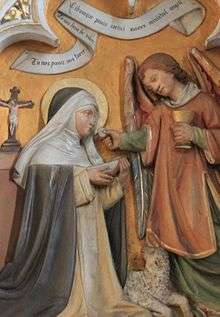Agnes of Montepulciano
| St. Agnes of Montepulciano, O.P. | |
|---|---|
 Saint Agnes miraculously receiving the Blessed Sacrament from an angel | |
| Born |
28 January 1268 Montepulciano, Papal States |
| Died |
20 April 1317 Montepulciano, Papal States |
| Venerated in |
Roman Catholic Church (Dominican Order) |
| Canonized | 1726 by Pope Benedict XIII |
| Major shrine | Church of St. Agnes, Montepulicano, Siena, Italy |
| Feast | 20 April |
| Attributes | Lily and a lamb |
Agnes of Montepulciano, O.P. (1268 – 1317), was a Dominican prioress in medieval Tuscany, who was known as a miracle worker during her lifetime. She is honored as a saint by the Catholic Church.
Life
Agnes was born in 1268 into the noble Segni family in Gracciano, a frazione of Montepulciano, then part of the Papal States. At the age of nine, she convinced her parents to allow her to enter a Franciscan monastery of women in the city known as the "Sisters of the Sack", after the rough religious habit they wore. they live a simple, contemplative life. She received the permission of the pope to be accepted into this life at such a young age, normally against Church law.<ref name=SB /[1]
In 1281, the lord of the castle of Proceno, a fief of Orvieto, invited the nuns of Montepulciano to send some of their Sisters to Proceno to found a new monastery. Agnes was among the nuns sent to found this new community. At the age of fourteen, she was appointed bursar.[2]
In 1288 Agnes, despite her youth at only 20 years of age, was noted for her devotion to the Blessed Sacrament and deep life of prayer, and was elected as the abbess of the community. There she gained a reputation for performing miracles: people suffering from mental and physical ailments seemed cured by her presence. She was reported to have "multiplied loaves", creating many from a few on numerous occasions, recalling the Gospel miracle of the loaves and fishes. She herself, however, suffered severe bouts of illness which lasted long periods of time.[3]
In 1306 Agnes was recalled to head the monastery in Montepulciano. Agnes reached a high degree of contemplative prayer and is said to have been favored with many visions. After her return, she proceeded to build a church, Santa Maria Novella, to honor the Blessed Mother, as she felt she had been commanded to do in a mystical vision several years earlier. She also had a vision of St. Dominic Guzman, under the inspiration of which she led the nuns of her monastery to embrace the Rule of St. Augustine as members of the Dominican Order.[2] She was frequently called upon to bring peace to the warring families of the city.[3]
By 1316, Agnes' health had declined so greatly that her doctor suggested taking the cure at the thermal springs in the neighboring town of Chianciano Terme. The nuns of the community prevailed upon her to take his recommendation. While many of the other bathers reported being cured of their illnesses, Agnes herself received no benefit from the springs. Her health failed to such a degree that she had to be carried back to the monastery on a stretcher.[3]
Veneration
Agnes died the following 20 April, at the age of forty-nine. The Dominican friars attempted to obtain balsam (or myrrh) to embalm her body. It was found, however, to be producing a sweet odor on its own, and her limbs remained supple.[3]
When her body was moved years after her death to the monastery church, it was found to be incorrupt.[4] Her tomb became the site of pilgrimages.
Some fifty years later, a Dominican friar, the Blessed Raymond of Capua, who served as confessor to St. Catherine of Siena, wrote an account of Agnes' life. He described her body as still appearing as if she were alive. Catherine herself referred to her as "Our mother, the glorious Agnes".[3] Catherine made a pilgrimage to Montepulciano while visiting her niece, Eugenie, who was a nun there.[2]
Agnes was canonized by Pope Benedict XIII in 1726. Her feast day is celebrated within the Dominican Order on 20 April.
See also
References
- ↑ "Sant' Agnese Segni di Montepulciano". Santi Beati (in Italian).
- 1 2 3 Dorcy, Marie Jean. St. Dominic's Family, Tan Books and Publishers, (1983)
- 1 2 3 4 5
- ↑ "St. Agnes of Montepuliciano". Catholic News Agency. 20 April 2012. Retrieved 20 December 2012.
External links
-
 This article incorporates text from a publication now in the public domain: Herbermann, Charles, ed. (1913). "article name needed". Catholic Encyclopedia. New York: Robert Appleton.
This article incorporates text from a publication now in the public domain: Herbermann, Charles, ed. (1913). "article name needed". Catholic Encyclopedia. New York: Robert Appleton. - Attwater, Donald and Catherine Rachel John. The Penguin Dictionary of Saints. 3rd edition. New York: Penguin Books, 1993. ISBN 0-14-051312-4.
- "Saint Agnes of Montepulciano" at the Christian Iconography website
| Wikimedia Commons has media related to Agnes of Montepulciano. |